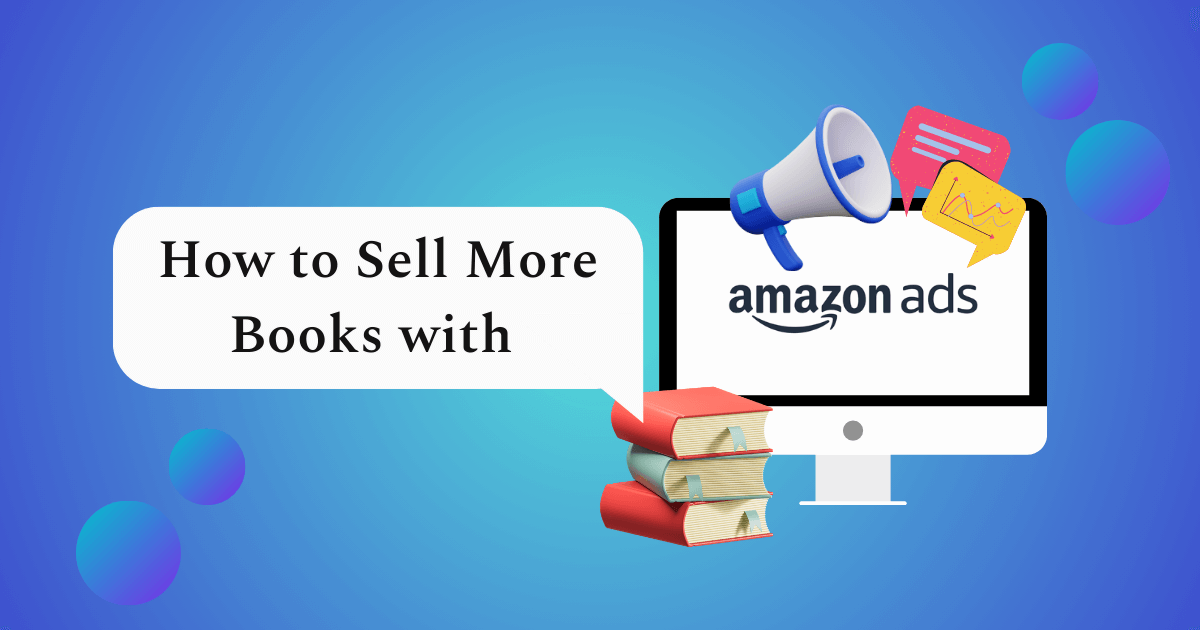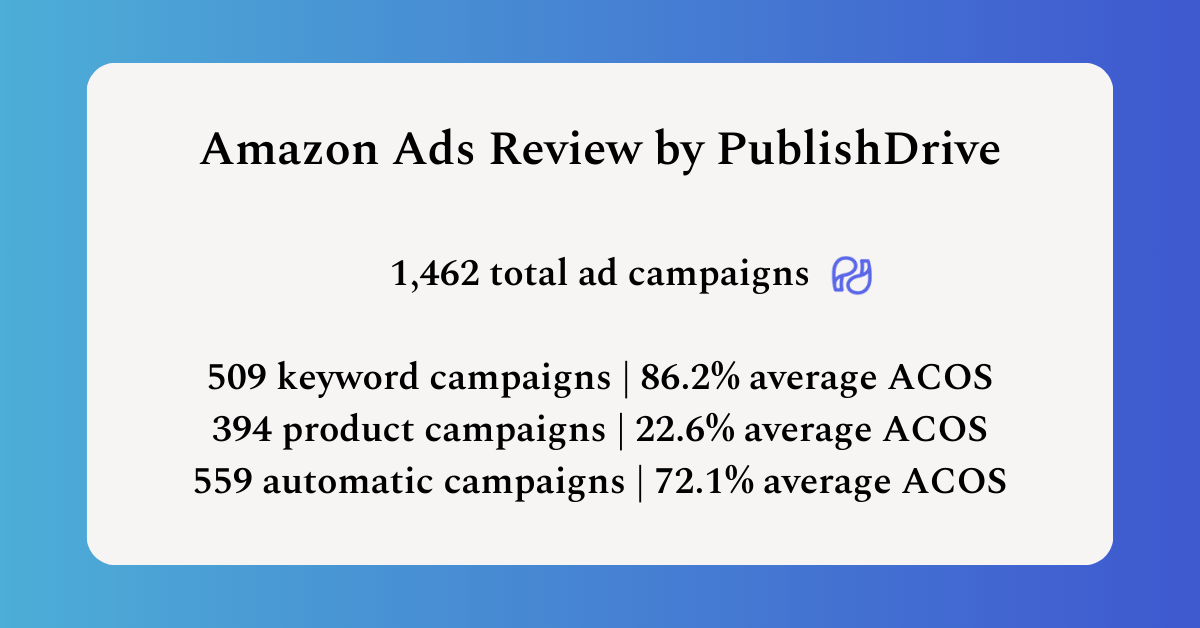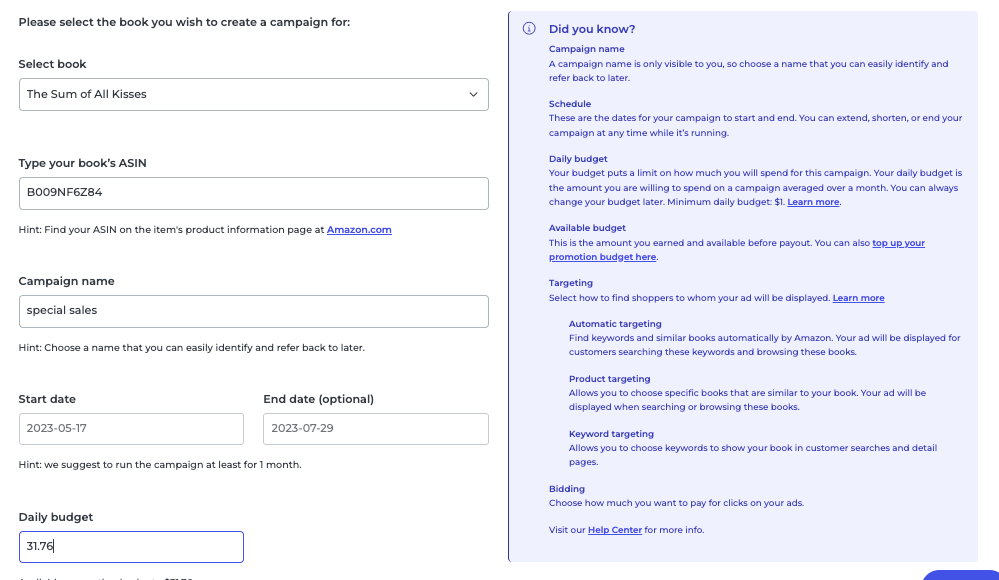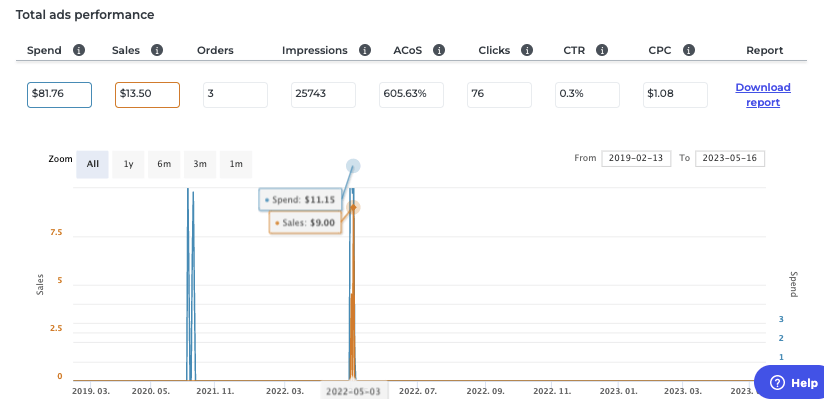Guide to Amazon Ads for Authors

Need a guide to Amazon Ads for authors? Look no further. We’ll go over the basics and best practices to know when using Amazon book advertising (with insights from over 1,400 ad campaigns.)
Let’s learn:
- What is Amazon Advertising for books
- Why Amazon Ads for books
- How to get started with Amazon book ads
- Best practices on Amazon Ads for books
- Using PublishDrive’s Amazon Ads tool
Main takeaways:
- Amazon Ads for authors can be a game changer, directly targeting consumers who are browsing on Amazon, the largest online retailer in the world.
- Successful Amazon AMS ads require careful consideration of targeting methods, bid strategies, and ongoing performance monitoring of metrics like CTR and ACOS.
- Optimize your ad performance by improving your book’s metadata like refreshing the description or landing more reviews to successfully convert clicks to sales.
What Is Amazon Advertising for Books?
Amazon AMS is the umbrella term for several Amazon marketing services for authors. Despite being rebranded to Amazon Advertising, many still refer to the services as AMS ads for books.
Essentially, Amazon Ads is Amazon's platform where you can advertise and sell products in front of visitors based on related products, keywords, and consumer interests.
For authors and publishers, the platform is available for Kindle Select and non-Kindle Select books. To learn about the difference between the two, see how to self-publish on Amazon.

There are three main types of Amazon book ads to know:
- Sponsored Products show up within and at the bottom of Amazon search results, on product detail pages, in the "Products related to this item" section, and sometimes on the home page.
- Sponsored Brands appear at the top of search results pages, within search results, and occasionally on product detail pages.
- Sponsored Display ads show up on product detail pages, below the "Add to Cart" button, within customer reviews, on the home page, and on third-party websites and apps outside of Amazon.
Why Amazon Ads for Authors?
Imagine Amazon as a gigantic, physical bookstore. In a sea of books, using Amazon Ads is like placing your book in places where it can be discovered.
- Using Sponsored Products is like displaying your book closer to the most popular books in the same genre, as well as in prominent locations throughout the store.
- Using Sponsored Brands is like having a branded banner at the entrance of a specific book section, showcasing your author brand or a collection of your books.
- Using Sponsored Display ads is like displaying your book in various high-visibility areas, including next to related books, near the checkout counter, and even in other stores that your potential readers might visit.
How to Get Started With Amazon Book Ads
Now, how to use Amazon Ads to sell books? Before expecting a surge in Amazon book sales, prepare to learn about how to use Amazon marketing services (like you're doing now!) Like many things, there is a significant learning curve. Here are nine pointers to know when starting out.
1. Each ad is a "campaign"
An ad is called a "campaign." Under a campaign, you set the maximum price you're willing to bid for the ad.
You also use either product or keyword targeting. For beginners, using "automatic" targeting is suggested.

2. Use product targeting
You can use product targeting to have your ad appear in related products suggested by Amazon or chosen by you. You'd need to insert your book's categories and related categories.
3. Work with keyword targeting
A keyword is any search term the customer types in the Amazon search field. For example, "vampire romance book" could be a keyword for your fantasy book about vampires. You can supply up to 1,000 keywords or keyword phrases. Using at least 20 AMS keywords is recommended.

Amazon suggests "automatic" keywords, but you can add your own "manual" keywords.
This targeting option is better suited for advanced users. More keyword strategies are shared under the best practices section further down.
4. Start with a low budget
When considering Amazon book advertising costs, do strategize your bidding approach. The Amazon ad cost varies based on keyword competitiveness and ad relevance.
You can start with a budget as low as $5 a day. Because you're charged the bid amount each time someone clicks on your ad, your daily budget should cap the maximum spend.
Authors often compete for the same keywords or placements. Your bid amount and ad relevance will determine if your ad appears. Amazon offers three bidding strategies:
- Dynamic bids – down only: Reduces bids for less relevant ads or poor placements.
- Dynamic bids – up and down: Increases bids for auctions likely to result in a sale.
- Fixed bids: Uses your exact bid without adjustments.
Raising the budget for a campaign does not necessarily make Amazon display the ad more frequently... We wish it were that easy. That's why it's crucial to start with a test campaign.
Remember to be patient with your results. Amazon counts sales in a 14-day window after an ad closes. It can take up to 90 days to get paid by Amazon for the sales made. It may take between a few days and a week to see sales generated for the previous period on your Amazon Ads dashboard.
5. Write a winning ad copy
Along with your budget and targeting, your ad requires a copy under 150 characters. There are restrictions on what you can claim in the ad (e.g. "Bestseller"). Check these guidelines on Amazon ad copy. Your ad includes an image as well, which Amazon supplies from your book product listings. You want to prepare your best designs.
6. Have an on-target cover and description
An ad gets your book in front of people, but it can only do so much. It's crucial to have a shining book cover design that makes people want to click and learn more. Look at bestselling designs in your genre. What do they have in common? Invest in a professional graphic designer if you can.
Your book description should be at its best as well. Is it compelling? Are the most emotional hooks in the first few sentences? You want to convince your audience to make a purchase at every corner. Check these book description hacks.
7. Ensure at least three solid reviews
Like your cover and description, reviews tell people if your book is worth buying. Before you waste any money on your ad efforts, do land a handful of solid reviews. Here's a list of book reviewers to reach out to. To help with your online credibility, don't forget to create an author page on Amazon.
8. Understand the metrics
When your campaign goes live, you'll want to understand these metrics:
- Clicks: The number of times someone clicked on your ad.
- Impressions: The number of times your ad is displayed, whether someone clicks (effective in boosting brand awareness.)
- CTR (click-through rate): The number of clicks divided by impressions, used to gauge how well you're converting. The higher your CTR, the better.
- ACOS (advertising cost of sales): How much you spend for every dollar of revenue you make, calculated by the total ad spend divided by the total sales. The lower your ACOS, the better.
9. Interpret your results
If your ad has low impressions, focus on improving your targeting method. You can use automatic targeting, which helps with getting more impressions, then optimize your conversions from there.
If your CTR is low, look at your book cover or description and see how it stacks up against the Top 100 in your primary categories. If overall sales are low, your ACOS may be too high.
Best Practices on Amazon Ads for Books
Ok, those are the basics. Now it's time for the nitty-gritty on advertising your book on Amazon. After analyzing more than 1,400 recent campaigns, PublishDrive identified eight key findings from the most successful ads.

P.S. PublishDrive is a self-publishing platform that helps indie authors and publishers sell and promote to Amazon and hundreds of other stores.
1. Look at metadata: promote higher-priced books for a better ACOS
Your ad may have a low conversion rate despite having a high impression and click rate. This means that your book has the right targeting, along with the cover and blurb being good enough to raise interest. But do take another look at your book metadata, such as pricing.
Do you have the right price for your book? From PublishDrive’s data, running ads for higher-priced books resulted in better sales. That’s because you can break even or achieve a higher profit with a lower ACOS.
On average, the best performing ads were:
✅
Paperbackabove $12
👌
Hardcoverabove $19.99
📈
Ebook/Kindle editions above $72. Improve CTR
Your ad can appear for many people but fail to convert into clicks, aka a struggle with CTR. This can be resolved by fixing your cover, the first sentences of your blurb, and adding your author page on Amazon.
When prioritizing CTR, there is an exception for book prices. Out of 1,400 campaigns, lower-priced books performed better by CTR. This meant that people liked to click on cheaper books. Additionally, using keyword and product targeting resulted in a way higher CTR than automatic targeting. This meant that using a more specific targeting method resulted in higher clicks.
3. Improve impressions
Without impressions, no one clicks on your book ad. That means you miss the chance to get people to buy. It’s important to appear in front of your target audience. Looking at your targeting and budget can help.
The best performing ads by impressions were priced above $12 and mostly fiction books. Here’s what else:
✅
Automatic and product targeting generated more impressions
👌
Automatic targeting was 3x more profitable
📈
Advertisers spent a lot more for higher impressions
📚
Books with more reviews and ratings above four stars significantly increased impressions
4. Improve ACOS
If you have a standalone book on the 70% royalty plan, maintain an ACOS below 70% to be in profit. If you have a book series, an ACOS of 150% for the first book works if half of your readers buy the rest of the books in your series.
With KDP Select royalties, your profit on the ad spend would be about 33%. This means for a monthly spend of $1,000, you get back $1,500. You can make more if you get your ACOS further down.
Here’s what the best-performing ads by ACOS shared:
✅
Paperback and hardcover
👌
Non-fiction books
📈
Priced above $12
📚
Used keyword targeting on buying behavior
☑️
Descriptions usually started with another author’s review
✌️
Cover designs matched its genre trends
5. Improve conversions
Here’s what the best performing ads by conversions shared:
✅
Automatic targeting had higher conversions👌
Ads with higher CTR had higher conversions📈
Books with more reviews and ratings had higher conversions from clicks, resulting in higher sales6. Pay attention to cost per click (CPC)
Another good metric to look at is your CPC. A low CPC of 25¢ means it costs 25¢ every time someone clicks on your ad. On average, one in ten people who click will buy your book. That accounts for costing you $2.50 for an actual sale. If you have only one book, don’t bid too high.
7. Choose your keywords
Although Amazon suggests keywords, we recommend doing your own AMS keyword search. Try these methods:
- Look at similar authors and titles: Create your list of keywords with similar authors and titles. Since you’re familiar with your own genre and audience, think about which books your ideal readers are most likely searching for.
- Look at the “also-bought” section of your book page: This shows you a list of items your readers also bought. What does it say about your people’s buying practices?
- Look at your current metadata keywords: Plug in your current keywords, such as subgenres, and look at related products. Are there any overlaps with the “also-boughts”?
- Look at searches made by others: Check what people are searching for. You can use Merchant Words or free keyword research tools like Google Trends. With your list of potential keywords, check how popular the authors and titles are.
8. Monitor, fine-tune, and optimize!
Last but not least, regularly review your performance and make adjusments. You want to not only generate more sales but prevent unnecessary costs. Monitoring your campaigns helps with that.
Ads may lose you money for a variety of reasons:
- Your ad copy is misleading.
- Your ad is running on pages too far removed from your target audience.
- Once arriving at your book page, the description, reviews, or other elements may not be up to par.
Set a schedule for yourself – commit to weekly or bi-weekly check-ins for reviewing performance. Record data on an Excel spreadsheet. Note the keywords resulting in the most sales. Don’t forget to monitor your impressions. If you have more than a few thousand impressions for a keyword and no clicks, suspend it because it’s obviously not working.
Advertising and selling on Amazon is the real deal, but it takes a willingness to learn and experiment to get it right. Since no one knows exactly how Amazon algorithms work, commit to monitoring and fine-tuning your Amazon Kindle advertising strategy on a continuous basis.
Putting it all together. In a nutshell, Amazon ads for authors are cost-per-click ads for print, audio, and ebook listings. You’ve probably seen them in Amazon’s search results or on product pages when browsing for a new book.
Since these ads are cost-per-click, you only pay when someone clicks on your ad. The ultimate goal is for those clicks to turn into sales. This is why it’s so important to nail your cover design and have a book description that hooks readers, among other things.
Using PublishDrive’s Amazon Ads Tool
On PublishDrive, anyone can set up Amazon Ads with the Amazon Ads tool, perfect for indies just starting out. You don’t need to distribute your book through PublishDrive to use the tool. Just create an account and start a draft of your book. It takes three simple steps to get your ads set up with PublishDrive. ⬇️
Step 1: Fund your marketing budget and select your book
You’ll need to fund your marketing budget: you can either make a deposit with PayPal or a card, or you can transfer money from your book earnings. Next, select the book you want to promote.

Step 2: Enter your campaign details
Enter the campaign details, such as the start and end dates, daily budget, and bid.

Step 3: Launch!
Hit “Launch” and PublishDrive handles the rest. You can edit your campaign details anytime, and you’ll have access to robust, downloadable sales data. The live analytics includes different types of performance indicators.

What else:
- Advanced targeting options: Refine your advertising strategy with manual keyword targeting, negative keywords, and product targeting.
- Artificial intelligence integration: PublishDrive’s AI Book Metadata Generator analyzes your content and makes suggestions based on industry standards, from sharing subtitle and blurb ideas to identifying relevant keywords and categories for Amazon, BISAC, Thema, and Apple Books. Learn more in the video below.
Set Up Amazon Ads for Authors Easily
PublishDrive's friendly Amazon Ads tool is perfect for beginners and novices. To optimize your metadata, watch this:
Here's what else:
✅ Sell ebook, audiobook, and print formats to all markets possible.
✅ Get support with marketing, royalty reporting, and beyond.
✅ Keep 100% of the royalties you earn.
✅ Publish your first ebook free.